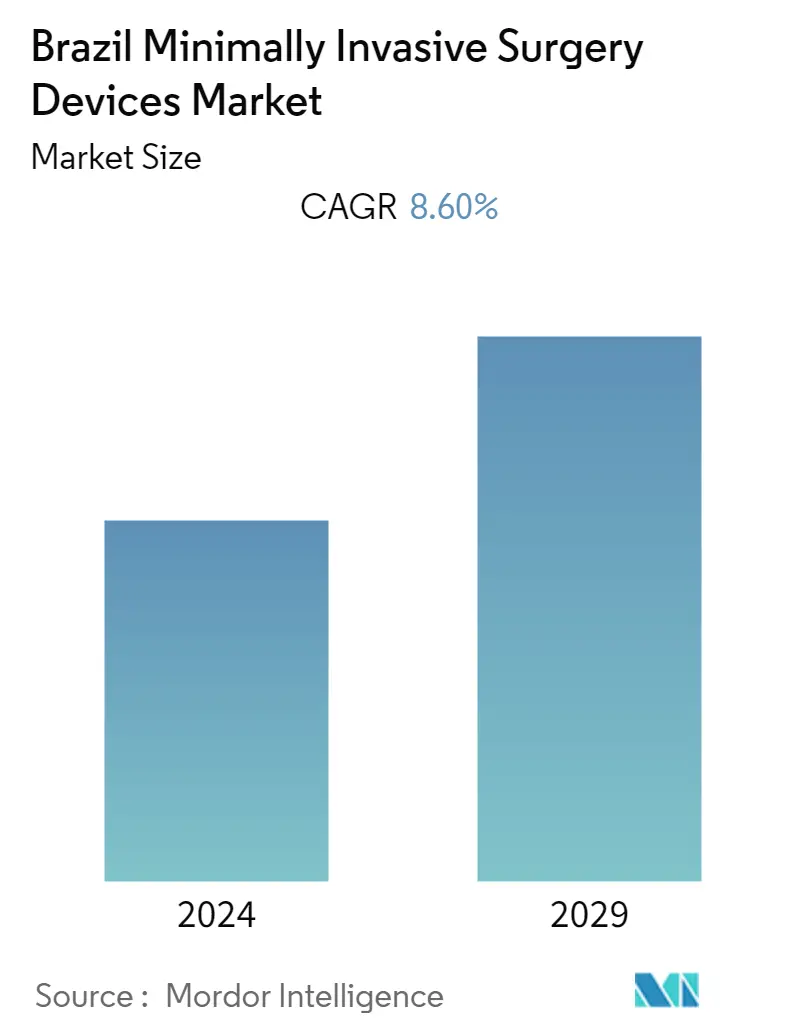Market Size of Brazil Minimally Invasive Surgery Devices Industry

| Study Period | 2019 - 2029 |
| Base Year For Estimation | 2023 |
| Forecast Data Period | 2024 - 2029 |
| Historical Data Period | 2019 - 2022 |
| CAGR | 8.60 % |
Major Players
*Disclaimer: Major Players sorted in no particular order |
Need a report that reflects how COVID-19 has impacted this market and its growth?
Brazil Minimally Invasive Surgery Devices Market Analysis
Brazil's minimally invasive surgery devices market is poised to grow at a CAGR of 8.6% during the forecast period.
The pandemic caused suspension of the surgical procedures worldwide that impacted the studied market. For instance, according to an article titled "Brazil: Plastic Surgery, Covid-19 and Self-Esteem" published in Harvard Review of Latin America in October 2021, at the initial stages of the pandemic in 2020, the Brazilian government instructed to postpone all elective procedures in order to free up beds for Covid-19 patients at hospitals and all non-emergency surgeries were delayed for months. Also, another article titled "Impact of COVID-19 Pandemic in a Pediatric and Congenital Cardiovascular Surgery Program in Brazil" published in the Brazilian Journal of Cardiovascular Surgery in March 2021, reported that a 66.7% decrease in pediatric and congenital cardiovascular surgeries patient volume during the pandemic, as compared to the previous year surgeries. Therefore, COVID-19 had an adverse impact on the studied market.
The prime advantage that minimally invasive surgeries has over traditional open surgeries is the higher precision, owing to video-assisted equipment involved, which generate better and magnified images of the organs or body parts that are operated, and also wider acceptance rate in the old adult population, due to the relatively shorter recovery time. In addition, higher acceptance rate of minimally-invasive surgeries over traditional surgeries, increasing prevalence of lifestyle-related and chronic disorders, and technological advancements are actively affecting the growth of the studied market.
The minimally invasive surgeries are used for lifestyle related or chronic diseases such as in cancer, colon and rectal surgery, gastroenterologic surgery, gynecologic surgery, neurosurgery, orthopedic surgery, otolaryngology (ear, nose and throat surgery) head and neck surgery, thoracic surgery, urologic surgery, and many more. As per the Government of Brazil February 2022 update, more than 12,000 organ transplants were performed in Brazil between January and November in 2021. Owing to the high number of transplants, Brazil is ranked second in the world for most transplant surgeries performed. The surge in minimally invasive surgeries are projected to boost the demand for minimally invasive surgery devices in the country.
Additionally, the advancements in technology and increasing product approvals, along with partnerships and acquisitions by key players are helping in the market growth. For instance, in September 2020, Sartori, a Brazil-based manufacturer of orthopaedic implants and instruments, acquired SLM Solution's Selective Laser Melting technology. With the acquisition of a new SLM280, the company was expected to address the increased demand for high-quality and affordable medical devices in the Brazil.
Therefore, owing to the aforementioned factors the studied market is anticipated to witness growth over the analysis period. However, shortage of experienced professionals and uncertain regulatory framework is likely to impede the market growth.
